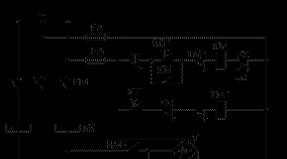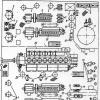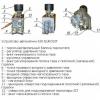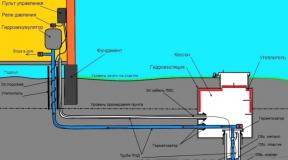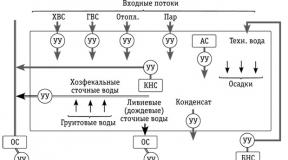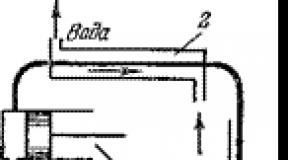Violation of the amount of synthesized protein. Disturbances in the formation and excretion of the end products of protein metabolism. Nitrogen imbalance
Among the causes of violations of protein synthesis, an important place is occupied by various types of nutritional deficiencies (complete, incomplete starvation, lack of essential amino acids in food, violation of a certain quantitative ratio between essential amino acids entering the body).
If, for example, in tissue protein tryptophan, lysine, valine are contained in equal ratios (1: 1: 1), and with food protein these amino acids come in a ratio of 1: 1: 0.5, then tissue protein synthesis will be provided exactly half. The absence of at least one (out of 20) essential amino acids in cells stops protein synthesis in general.
Disruption in the rate of protein synthesis may be due to a disorder in the function of the corresponding genetic structures. Damage to the genetic apparatus can be both hereditary and acquired, arising under the influence of various mutagenic factors (ionizing radiation, ultraviolet rays, etc.). Some antibiotics cause protein synthesis disorders. So, "errors" in reading the genetic code can occur under the influence of streptomycin, neomycin and other antibiotics. Tetracyclines inhibit the addition of new amino acids to the growing polypeptide chain (the formation of strong covalent bonds between its chains), preventing the cleavage of DNA strands.
One of the important reasons for the violation of protein synthesis may be a violation of the regulation of this process. Regulation of the intensity and direction of protein metabolism is controlled by the nervous and endocrine systems, the effects of which are realized by influencing various enzyme systems. Desebration of animals leads to a decrease
protein synthesis. Growth hormone, sex hormones and insulin stimulate protein synthesis under certain conditions. Finally, the cause of its pathology may be a change in the activity of the enzyme systems of cells involved in protein synthesis.
The result of these factors is a decrease in the rate of synthesis of individual proteins.
Quantitative changes in the synthesis of proteins can lead to a change in the ratio of individual fractions of proteins in the blood serum - dysproteinemia. There are two forms of dysproteinemia: hyperproteinemia (an increase in the content of all or certain types of proteins) and hypoproteinemia (a decrease in the content of all or individual proteins). So, some liver diseases (cirrhosis, hepatitis), kidneys (nephritis, nephrosis) are accompanied by a decrease in albumin synthesis and a decrease in its content in serum. A number of infectious diseases, accompanied by extensive inflammatory processes, lead to an increase in the synthesis and subsequent increase in the content of gamma globulins in the serum. The development of dysproteinemia is accompanied, as a rule, by shifts in homeostasis (violation of oncotic pressure, water balance). A significant decrease in the synthesis of proteins, especially albumin and gamma globulins, leads to a sharp decrease in the body's resistance to infection.
With liver and kidney damage, some acute and chronic inflammatory processes (rheumatism, infectious myocarditis, pneumonia), qualitative changes occur in protein synthesis, while special proteins with altered properties are synthesized, for example, C-reactive protein. Examples of diseases caused by the presence of abnormal proteins are diseases associated with the presence of abnormal hemoglobin (hemoglobinosis), blood clotting disorders when abnormal fibrinogens appear. Unusual blood proteins include cryoglobulins, which can precipitate at temperatures below 37 ° C (systemic diseases, liver cirrhosis).
Preferanskaya Nina Germanovna
Associate Professor, Department of Pharmacology, Faculty of Pharmacy, First Moscow State Medical University THEM. Sechenov
Antibiotics are mainly bacteriostatic, with the exception of aminoglycosides, which have a bactericidal effect, and drugs used in high doses. These drugs have a wide spectrum of antimicrobial action and are often used in clinical practice, they are especially indispensable in the specific treatment of such rare infections as bartonellosis, brucellosis, cryptosporidiosis, cystic fibrosis, toxoplasmosis, tularemia, tuberculosis, anthrax, cholera, plague, etc.
Part I. Macrolides
Macrolides are a class of antibiotics that contain a macrocyclic lactone ring in the molecule, linked to carbohydrate residues of amino sugars. Depending on the number of carbon atoms making up the ring, 14-membered, 15-membered and 16-membered macrolides are isolated. Of all existing antibiotics, macrolides have established themselves as highly effective and safest chemotherapeutic agents. Macrolides are divided into two groups: natural and semi-synthetic .
The antimicrobial effect of macrolides is due to a violation of protein synthesis on the ribosomes of a microbial cell. Macrolides reversibly bind to various domains of the catalytic peptyl-transferase center of the 50S -subunit of ribosomes and inhibit the processes of translocation and transpeptidation of peptides, which leads to the termination of the assembly of the protein molecule and slows down the ability of microorganisms to divide and multiply. Depending on the type of microorganism and concentration of the drug, they have a dose-dependent effect, while exhibiting a bacteriostatic effect, in large doses and on some strains of microorganisms - bactericidal. The antimicrobial spectrum of action is very close to the group of natural penicillins.
Macrolides have lipophilic properties, are rapidly absorbed in the gastrointestinal tract, create high tissue and intracellular concentrations, being distributed in many tissues and secretions, are poorly retained in extracellular fluids, and do not penetrate the BBB. Their action is manifested mainly at the stage of reproduction. They are highly effective only against actively dividing microorganisms, therefore they have proven themselves well in the treatment of the acute period of the disease and are inactive or have practically no effect on sluggish processes.
They have increased activity against gram "+" cocci and intracellular pathogens (chlamydia, mycoplasma, legionella), suppress the development of gram-negative cocci, diphtheria sticks, pathogens of brucellosis, amoebic dysentery. Per gram "-" microorganisms of the family Enterobacteriaceae P. aeruginosa and gram "-" anaerobes are resistant. Pseudomonas and acinetobacters are naturally resistant to all macrolides. The resistance of microorganisms to this group of drugs is associated with a change in the structure of receptors on the 50S -subunits of ribosomes, which leads to a violation of the binding of the antibiotic to the ribosomes. In macrolides, lincosamides, and fenicols, binding to the 50S-subunit of ribosomes occurs at different sites, which leads to the absence of cross-resistance. A feature of the antimicrobial action of macrolides is the bacteriostatic effect against those forms of bacteria that are resistant to such widely used groups as penicillins, streptomycins, tetracyclines.
Macrolides are used for lower respiratory tract infections, including atypical forms, exacerbation of chronic bronchitis and community-acquired pneumonia. They are prescribed for upper respiratory tract infections (sinusitis, otitis media, pharyngitis, tonsillitis), infections of the oral cavity, soft tissues, skin, infected acne and urogenital infections. The indications for their use are the prevention and treatment of mycobacteriosis, the prevention of rheumatic fever, endocarditis, in order to eradicate H. pylori ( clarithromycin). The immunomodulatory properties of macrolides are used for panbronchonchiolitis ( clarithromycin, roxithromycin) and cystic fibrosis ( azithromycin).
The main side effects when using macrolides are gastrointestinal disorders, the risk of which does not exceed 5-8%. In rare cases, allergic reactions of 2-3% develop (skin rash, swelling of the face, neck, feet, anaphylactic shock), less often cholestatic hepatitis and pseudomembranous colitis. The smallest frequency of administration of macrolides, improved pharmacokinetic parameters do not require dose adjustment in renal failure and are well tolerated by patients. Most macrolides (especially erythromycin and clarithromycin) are potent inhibitors of cytochrome P-450 (CYP 3A 4, CYP3A5, CYP3A7, CYP 1A 2), therefore, against the background of their use, biotransformation is disturbed and the maximum concentration in the blood of joint drugs increases. This is especially important to consider when applying Warfarin, Cyclosporine, Theophylline, Digoxin, Carbamazepine and others, which are metabolized in the liver. Their combined use can cause the most dangerous complications (heart rhythm disturbance, lengthening of the Q-T interval, development of limb ischemia and gangrene). Spiramycin and azithromycin do not undergo oxidation by cytochrome P-450. In the body, macrolides undergo enterohepatic recirculation, are excreted mainly in the bile, and only 5-10% of the drug is excreted by the kidneys.
Erythromycin (Erytromycinum)produced by soil actinomycetes (radiant fungi), from the culture fluid of which it was isolated in 1952. It is well absorbed from the gastrointestinal tract. In an acidic environment, the stomach is partially destroyed, therefore, erythromycin should be administered in tablets coated with an acid-resistant coating, which dissolves only in the intestine. The drug easily penetrates into various tissues, incl. overcomes the placental barrier. Under normal conditions, it does not enter the brain tissue. After a single oral administration, the maximum concentration in the blood is reached after 2 hours. Erythromycin has a bioavailability of 2-3 hours, therefore, to maintain a therapeutic level in the blood, it should be administered 4 times a day. Higher doses inside: single - 0.5 g, daily - 2 g. Excreted in feces and, partially, in urine. Erythromycin tablets are most widely used for the treatment of pneumonia, bronchitis of various etiologies, scarlet fever, tonsillitis, purulent otitis media, diphtheria, and wound infections. The drug is used in severe infectious diseases, for the treatment of whooping cough, diphtheria. With conjunctivitis of newborns, it is administered intravenously, a single dose is diluted in 250 ml of isotonic sodium chloride solution, injected slowly over an hour. With gastroparesis, erythromycin dose-dependently causes stimulation of gastric motility, increases the amplitude of contractions of the pylorus and improves antral-duodenal coordination. It is used locally in the form of an ointment and solution for external use for the treatment of purulent-inflammatory skin diseases, infected wounds, trophic ulcers, pressure sores and burns of II-III degree. Resistance of microorganisms rapidly develops to erythromycin, the drug is low-toxic and rarely causes side effects. Sometimes there are dyspeptic disorders (nausea, vomiting), allergic reactions. Bioavailability is significantly reduced when erythromycin is taken with or after meals, because food reduces the concentration of this antibiotic in the blood by more than 2 times. Produced in TB., Cover. obol. 100 and 250 mg; eye ointment 10 g (in 1 g 10,000 units); ointment for external and local use 15 mg - 10 thousand units / g. Suppositories for children, 0.05 g and 0.1 g. Powder for injections, 0.05, 0.1 and 0.2 g each, and granules for suspension, 0.125 g and 0.2 g each in 5 ml vials.
There are also toxic effectsassociated with the direct action of xenobiotics on microsomal monooxygenases. The mechanism of the toxic action of carbon tetrachloride is typical here, which dissolves in all membrane elements of liver cells with predominant accumulation in the microsomal fraction. Here, it binds to cytochrome P-450, and the rapidly proceeding reduction reaction leads to the formation of the CCl3 radical, which is the starting link in the mechanism of the damaging action of this xenobiotic.
The radical stimulates sharply lipid peroxidation, causing damage to biomembranes, and leads to the destruction of cytochrome P-450. As a result, these mechanisms, together with others, less essential, cause cell death. For the mechanism of toxicity described here in brief, AI Archakov introduced the term "lethal decay".
When interacting xenobiotics with microsomal monooxygenases, not radicals can be formed, but stable highly toxic products leading to intoxication. This version of the toxic effect is called "lethal synthesis". For example, the formation of toxic fluorocitric acid from fluoroacetate, the accumulation of formaldehyde and formic acid during the oxidative conversion of methanol, etc.
All the chemicals damaging protein synthesis, can be divided into 2 groups. The first of them includes xenobiotics, which have an indirect effect on protein synthesis through changes in bioenergy processes, hormonal status, biomembrane permeability, etc. Violation of protein synthesis in the mechanism of their toxic effect is a secondary phenomenon that complicates, but does not determine the development of intoxication. An example would be chlorohydrocarbons. Thus, tetrachloroalkanes inhibit the incorporation of methionine and lysine into serum proteins and liver proteins.
There is another mechanism.: in the process of metabolism of xenobiotics, active radicals and peroxides are formed, affecting the phospholipids of the membranes of the endoplasmic reticulum and damaging them, which contributes to the disruption of protein synthesis. In particular, inhalation of dichloroethane leads to inhibition of the incorporation of leucine into liver proteins in mice and causes damage to the polyribosomal structures of hepatocytes. With silicosis in the lungs, the synthesis of macrophage protein is inhibited; in chronic beryllium disease, the processes of incorporating amino acids into lung proteins are disrupted. Under the influence of lead, the use of methionine for protein synthesis is inhibited; this process is suppressed by organomercury compounds.
Second group xenobiotics includes compounds that directly inhibit protein synthesis either by interfering with transcription processes or translation processes. A significant portion of xenobiotics disrupt transcription processes by damaging the matrix, i.e. DNA Under their influence, the covalent bonds between nucleotides are disrupted and their functional groups are modified due to the formation of complexes, the loss or destruction of sections of the DNA chain. This is how alkylating compounds work. A large group of antibiotics blocks DNA. The matrix properties of DNA are damaged by a large class of xenobiotics of the acridine series, intercalating between the bases of nucleic acids.
As a result decreased synthesis of mRNA (matrix ribonucleic acid) and protein biosynthesis is inhibited. Amanitins, products of poisonous fungi of the genus Amanita, disrupt transcription by inhibiting the activity of RNA polymerase, which also leads to suppression of protein synthesis.
Xenobioticsthat violate the broadcast can be divided into groups depending on the stage of the broadcast on which they act. For example, at the stage of initiation of the translation process, dihydroxybutyraldehyde and methylglyoxal, synthetic anions - polyvinyl sulfate, polydextran sulfate, etc., trichothecene toxins of fungi act. Moreover, the mechanism of their action can be different: aliphatic aldehydes block the attachment of mRNA to ribosomes; polyvinyl sulfate binds to ribosomes at the site where mRNA is attached; other polyanions block the interaction of ribosomal subunits. Xenobiotics that disrupt translation at the elongation stage can also have a different mechanism of action. For example, the formation of a peptide bond at the elongation step is blocked by erythromycin and oleandomycin. Diphtheria toxin interferes with translocation. Cycloheximide and its derivatives disrupt translocation in a slightly different way. At the stage of termination of the translation process, tenuazonic acid acts, suppressing the separation of newly formed proteins from ribosomes.
In conclusion of consideration protein synthesis disorders xenobiotics let us point out the possibility of suppressing the processes of activation of amino acids and inhibition of the activity of aminoacyl-tRNA synthetases. Substances that act in this way primarily include synthetic analogs of natural amino acids, for example, 5-methyltryptophan, 2-methylhistidine, methylhomocysteine, cisfluoroproline, fluorophenylalanine, ethionine, canavanin, etc. These xenobiotics inhibit the incorporation of natural amino acids into proteins by competitive inhibition corresponding aminoacyl synthetases.
General biological mechanism realization of toxic effects there is also a violation of bioenergetic processes, usually associated with the mitochondrial structural-metabolic complex.
Metabolic disorders underlie all functional and organic damage to organs and tissues leading to the onset of the disease. At the same time, metabolic pathology can aggravate the course of the underlying disease, acting as a complicating factor.
One of the most common reasons general violations protein metabolism is a quantitative or qualitative protein deficiency of primary (exogenous) origin. It may be due to:
1. violation of the breakdown and absorption of proteins in the gastrointestinal tract;
2. slowing down the flow of amino acids into organs and tissues;
3. violation of protein biosynthesis;
4. violation of the interstitial exchange of amino acids;
5. a change in the rate of protein breakdown;
6. pathology of the formation of end products of protein metabolism.
Disorders of protein breakdown and absorption... In the digestive tract, proteins are broken down under the influence of proteolytic enzymes. At the same time, on the one hand, protein substances and other nitrogenous compounds lose their specific features.
The main reasons for insufficient breakdown of proteins are a quantitative decrease in the secretion of hydrochloric acid and enzymes, a decrease in the activity of proteolytic enzymes (pepsin, trypsin, chymotrypsin) and the associated insufficient formation of amino acids, a decrease in the time of their exposure (acceleration of peristalsis).
In addition to general manifestations of amino acid metabolism disorders, there may be specific disorders associated with the absence of a specific amino acid. So, the lack of lysine (especially in a developing organism) retards growth and general development, lowers the content of hemoglobin and erythrocytes in the blood. With a lack of tryptophan in the body, hypochromic anemia occurs. Arginine deficiency leads to impaired spermatogenesis, and histidine - to the development of eczema, growth retardation, inhibition of hemoglobin synthesis.
In addition, insufficient digestion of protein in the upper gastrointestinal tract is accompanied by an increase in the transfer of products of its incomplete breakdown into the large intestine and an increase in the process of bacterial breakdown of amino acids. This leads to an increase in the formation of toxic aromatic compounds (indole, skatole, phenol, cresol) and the development of general intoxication of the body with these decay products.
Slow down the intake of amino acids into organs and tissues. Since a number of amino acids are the starting material for the formation of biogenic amines, their retention in the blood creates conditions for the accumulation of the corresponding proteinogenic amines in tissues and blood and the manifestation of their pathogenic effect on various organs and systems. The increased content of tyrosine in the blood contributes to the accumulation of tyramine, which is involved in the pathogenesis of malignant hypertension. Prolonged increase in the amount of histidine leads to an increase in the concentration of histamine, which contributes to impaired blood circulation and capillary permeability. In addition, an increase in the content of amino acids in the blood is manifested by an increase in their excretion in the urine and the formation of a special form of metabolic disorders - aminoaciduria. Aminoaciduria can be general, associated with an increase in the concentration of several amino acids in the blood, or selective - with an increase in the content of any one amino acid in the blood.
Disruption of protein synthesis... The synthesis of protein structures in the body is the central link in protein metabolism. Even small violations of the specificity of protein biosynthesis can lead to profound pathological changes in the body.
The absence of at least one (out of 20) essential amino acids in cells stops protein synthesis in general.
Violation of the rate of protein synthesis may be due to a disorder in the function of the corresponding genetic structures on which this synthesis takes place (DNA transcription, translation).
Damage to the genetic apparatus can be either hereditary or acquired, arising under the influence of various mutagenic factors (ionizing radiation, ultraviolet rays, etc.). Impaired protein synthesis can be caused by some antibiotics. So, "errors" in reading the genetic code can occur under the influence of streptomycin, neomycin and several other antibiotics. Tetracyclines inhibit the attachment of new amino acids to the growing polypeptide chain. Mitomycin inhibits protein synthesis through DNA alkylation (the formation of strong covalent bonds between its chains), preventing the cleavage of DNA strands.
Allocate quality and quantitative protein biosynthesis disorders. The importance of qualitative changes in protein biosynthesis in the pathogenesis of various diseases can be judged by the example of certain types of anemia with the appearance of pathological hemoglobins. Replacing only one amino acid residue (glutamine) in the hemoglobin molecule with valine leads to a serious illness - sickle cell anemia.
Of particular interest are quantitative changes in the biosynthesis of organ and blood proteins, leading to a shift in the ratios of individual protein fractions in serum - dysproteinemia. There are two forms of dysproteinemia: hyperproteinemia (increase in the content of all or certain types of proteins) and hypoproteinemia (decrease in the content of all or individual proteins). So, a number of liver diseases (cirrhosis, hepatitis), kidneys (nephritis, nephrosis) are accompanied by a pronounced decrease in the content of albumin. A number of infectious diseases, accompanied by extensive inflammatory processes, lead to an increase in the content of gamma globulins. Development dysproteinemia It is accompanied, as a rule, by serious changes in the homeostasis of the body (violation of oncotic pressure, water metabolism). A significant decrease in the synthesis of proteins, especially albumin and gamma globulins, leads to a sharp decrease in the body's resistance to infection, and a decrease in immunological resistance. The importance of hypoproteinemia in the form of hypoalbuminemia is also determined by the fact that albumin forms more or less strong complexes with various substances, ensuring their transport between different organs and transfer through cell membranes with the participation of specific receptors. It is known that salts of iron and copper (extremely toxic to the body) at a blood serum pH are difficult to dissolve and their transport is possible only in the form of complexes with specific serum proteins (transferrin and ceruloplasmin), which prevents intoxication with these salts. About half of the calcium is retained in the blood in the form associated with serum albumin. In this case, a certain dynamic equilibrium is established in the blood between the bound form of calcium and its ionized compounds. For all diseases accompanied by a decrease in the content of albumin (kidney disease), the ability to regulate the concentration of ionized calcium in the blood is also weakened. In addition, albumin are carriers of some components of carbohydrate metabolism (glucoproteins) and the main carriers of free (unesterified) fatty acids, a number of hormones.
With damage to the liver and kidneys, a number of acute and chronic inflammatory processes (rheumatism, infectious myocardium, pneumonia), special proteins with altered properties or an unusual norm begin to be synthesized in the body. A classic example of diseases caused by the presence of pathological proteins are diseases associated with the presence of pathological hemoglobin (hemoglobinosis). Blood coagulation disorders occur with the appearance of pathological fibrinogen. Unusual blood proteins include cryoglobulins, which can precipitate at temperatures below 37 ° C, which leads to thrombosis. Their appearance is accompanied by nephrosis, cirrhosis of the liver and other diseases.
Pathology of interstitial protein metabolism (violation of the exchange of amino acids).
Central to interstitial protein metabolism is reaction reaminationas the main source of the formation of new amino acids. Violation of transamination can occur as a result of a deficiency in the body of vitamin B 6. This is because the phosphorylated form of vitamin B 6 - phosphopyrodoxal is an active group of transaminases - specific transamination enzymes between amino - and keto acids. Pregnancy, prolonged intake of sulfonamides inhibit the synthesis of vitamin B 6 and can serve as the basis for metabolic disorders of amino acids. Finally, the inhibition of transamination activity can be caused by inhibition of transaminase activity due to a violation of the synthesis of these enzymes (with protein starvation), or a violation of the regulation of their activity by a number of hormones.
The processes of transamination of amino acids are closely related to the processes oxidative deaminationduring which the enzymatic cleavage of ammonia from amino acids. Deamination determines both the formation of end products of protein metabolism and the entry of amino acids into energy metabolism. The weakening of deamination can occur due to a violation of oxidative processes in tissues (hypoxia, hypovitaminosis C, PP, B2). However, the most severe violation of deamination occurs with a decrease in the activity of amino oxidases, either due to a weakening of their synthesis (diffuse liver damage, protein deficiency), or as a result of a relative insufficiency of their activity (an increase in the content of free amino acids in the blood). A consequence of a violation of oxidative deamination of amino acids will be the weakening of urea, an increase in the concentration of amino acids and an increase in their excretion in the urine - aminoaciduria.
The interchange of a number of amino acids takes place not only in the form of transamination and oxidative deamination, but also by their decarboxylation (loss of CO 2 from the carboxyl group) with the formation of the corresponding amines, called "biogenic amines". Thus, upon decarboxylation of histidine, histamine is formed, tyrosine - tyramine, 5-hydroxytryptophan - serotin, etc. All these amines are biologically active and have a pronounced pharmacological effect on blood vessels.
Change in protein breakdown rate. A significant increase in the rate of breakdown of tissue and blood proteins is observed with increasing body temperature, extensive inflammatory processes, severe injuries, hypoxia, malignant tumors, etc., which is associated either with the action of bacterial toxins (in case of infection), or with a significant increase in proteolytic activity blood enzymes (with hypoxia), or the toxic effect of tissue breakdown products (with injuries). In most cases, the acceleration of protein breakdown is accompanied by the development of a negative nitrogen balance in the body due to the predominance of protein breakdown processes over their biosynthesis.
Pathology of the final stage of protein metabolism. The main end products of protein metabolism are ammonia and urea. Pathology of the final stage of protein metabolism can manifest itself as a violation of the formation of final products, or a violation of their elimination.
Main mechanism ammonia binding is the process of urea formation in the citrulline-arginine-nornithine cycle. Disturbances in the formation of urea can occur as a result of a decrease in the activity of the enzyme systems involved in this process (hepatitis, cirrhosis), and general protein deficiency. In case of violation of urea formation in the blood and tissues, ammonia accumulates and the concentration of free amino acids increases, which is accompanied by the development of hyperazotemia. In severe forms of hepatitis and liver cirrhosis, when its urea-forming function is sharply impaired, severe ammonia intoxication develops (dysfunction of the central nervous system).
In other organs and tissues (muscles, nerve tissue), ammonia binds in the amidation reaction with the addition of free dicarboxylic amino acids to the carboxyl group. The main substrate is glutamic acid.
Another end product of protein metabolism resulting from oxidation creatine (muscle nitrogenous substance) is creatinine. With starvation, vitamin E deficiency, febrile infectious diseases, thyrotoxicosis and a number of other diseases, creatinuria indicates a violation of creatine metabolism.
In violation of the excretory function of the kidneys (nephritis), urea and other nitrogenous products in the blood are delayed. Residual nitrogen increases - hyperazotemia develops. An extreme degree of impaired excretion of nitrogen metabolites is uremia.
With simultaneous damage to the liver and kidneys, there is a violation of the formation and excretion of the final products of protein metabolism.
In pediatric practice, hereditary aminoacidopathies are of particular importance, the list of which currently includes about 60 different nosological forms. By type of inheritance, almost all of them are autosomal recessive. Pathogenesis is due to the failure of a particular enzyme that carries out catabolism and anabolism of amino acids. A common biochemical sign of aminoacidopathy is tissue acidosis and aminoaciduria. The most common hereditary metabolic defects are four enzymes that are linked by a common amino acid metabolism: phenylketonuria, tyrosinemia, albinism, and alkaponuria.
Carbohydrates make up the mandatory and most of human food (about 500 g / day). Carbohydrates are the most easily mobilized and recyclable material. They are deposited in the form of glycogen, fat. During carbohydrate metabolism, NADP · H 2 is formed. Carbohydrates play a special role in the energy of the central nervous system, since glucose is the only source of energy for the brain.
Carbohydrate metabolism disorder may be due to a violation of their digestion and absorption in the digestive tract. Exogenous carbohydrates enter the body in the form of poly-, di - and monosaccharides. Their splitting mainly occurs in the duodenum and small intestine, the juices of which contain active amylolytic enzymes (amylase, maltase, sucrase, lactase, invertase, etc.). Carbohydrates are broken down to monosaccharides and absorbed. If the production of amylolytic enzymes is insufficient, then di - and polysaccharides supplied with food are not split into monosaccharides and are not absorbed. Absorption of glucose suffers when its phosphorylation in the intestinal wall is impaired. The basis of this violation is the deficiency of the enzyme hexokinase, which develops in severe inflammatory processes in the intestine, with poisoning with monoiodoacetate, floridzin. Unphosphorylated glucose does not pass through the intestinal wall and is not absorbed. Carbohydrate starvation may develop.
Violation of the synthesis and breakdown of glycogen. A pathological increase in the breakdown of glycogen occurs with strong excitation of the central nervous system, with an increase in the activity of hormones that stimulate glycogenolysis (STH, adrenaline, glucagon, thyroxine). An increase in the breakdown of glycogen while increasing muscle consumption of glucose occurs with severe muscle load. Glycogen synthesis may change in the direction of decrease or pathological amplification.
Decreased glycogen synthesis occurs with severe damage to the liver cells (hepatitis, poisoning by liver poisons), when their glycogen-forming function is impaired. The synthesis of glycogen decreases with hypoxia, since under the conditions of hypoxia the formation of ATP, necessary for the synthesis of glycogen, decreases.
Hyperglycemia- an increase in blood sugar levels above normal. It can develop in physiological conditions; at the same time it has adaptive value, since it ensures the delivery of energy material to the tissues. Depending on the etiological factor, the following types of hyperglycemia are distinguished.
Alimentary hyperglycemia that develops after taking a large amount of easily digestible carbohydrates (sugar, sweets, flour products, etc.).
Neurogenic (emotional) hyperglycemia - with emotional arousal, stress, pain, ether anesthesia.
Hormonal hyperglycemia is accompanied by dysfunction of the endocrine glands, the hormones of which are involved in the regulation of carbohydrate metabolism.
Hyperglycemia with insulin hormone deficiency is the most pronounced and persistent. It can be pancreatic (absolute) and extrapancreatic (relative).
Pancreatic Insulin Deficiency develops when the insular apparatus of the pancreas is destroyed or damaged. A common cause is local hypoxia of the islets of Langerhans with atherosclerosis, vasospasm. In this case, the formation of disulfide bonds in insulin is disturbed and insulin loses activity - it does not have a hypoglycemic effect.
The destruction of the pancreas by tumors, damage to its infectious process (tuberculosis, syphilis) can lead to insulin deficiency. The formation of insulin can be impaired in pancreatitis - acute inflammatory and degenerative processes in the pancreas.
The insular apparatus is overexerted and can be depleted when excessive and frequent consumption of easily digestible carbohydrates (sugar, sweets), overeating, which leads to alimentary hyperglycemia.
A number of drugs (thiazide groups, corticosteroids, etc.) can cause impaired glucose tolerance, and in diabetes-prone individuals, they can be a trigger factor in the development of this disease.
Extra pancreatic insulin deficiency. Its cause may be an excessive connection of insulin with transmitting blood proteins. Protein-bound insulin is only active against adipose tissue. It provides the conversion of glucose to fat, inhibits lipolysis. In this case, the so-called obese diabetes develops.
With diabetes, all types of metabolism are disturbed.
Carbohydrate metabolism determine the characteristic symptom of diabetes - persistent severe hyperglycemia. It is determined by the following features of carbohydrate metabolism in diabetes mellitus: a decrease in the passage of glucose through cell membranes and assimilation of its tissues; slowing down the synthesis of glycogen and accelerating its breakdown; increased gluconeogenesis - the formation of glucose from lactate, pyruvate, amino acids and other products of non-carbohydrate metabolism; inhibition of the conversion of glucose to fat.
The importance of hyperglycemia in the pathogenesis of diabetes is twofold. It plays a certain adaptive role, since it inhibits the breakdown of glycogen and partially increases its synthesis. Glucose penetrates tissues more easily, and they do not experience a sharp lack of carbohydrates. Hyperglycemia is also negative. With it, the influx of glucose into the cells of insulin-independent tissues (the lens, liver cells, beta cells of the islets of Langerhans, nerve tissue, red blood cells, and the aortic wall) sharply increases. Excess glucose is not phosphorylated, but converted to sorbitol and fructose. These are osmotically active substances that disrupt the metabolism in these tissues and cause their damage. With hyperglycemia, the concentration of gluco - and mucoproteins increases, which easily fall out in the connective tissue, contributing to the formation of hyaline.
With hyperglycemia exceeding 8 mol / l, glucose begins to pass into the final urine - glucosuria develops. This is a manifestation of the decompensation of carbohydrate metabolism.
In diabetes mellitus, the processes of phosphorylation and dephosphorylation of glucose in the tubules can not cope with an excess of glucose in primary urine. In addition, with diabetes, the activity of hexokinase is reduced, therefore, the renal threshold for glucose decreases compared to normal. Glucosuria develops. In severe forms of diabetes, the sugar content in the urine can reach 8-10%. The osmotic pressure of urine increases, and therefore a lot of water passes into the final urine. 5-10 l or more urine (polyuria) with a high relative density due to sugar is released per day. As a result of polyuria, dehydration of the body develops, and as a result of it - increased thirst (polydipsia).
With a very high blood sugar level (30-50 mol / L and higher), the osmotic pressure of the blood rises sharply. The result is dehydration. Hyperosmolar coma may develop. The condition of patients with it is extremely serious. Consciousness is absent. The signs of tissue dehydration (eyeballs soft on palpation) are pronounced. With very high hyperglycemia, the level of ketone bodies is close to normal. As a result of dehydration, kidney damage occurs, and their function is impaired until the development of renal failure.
Pathological changes in fat metabolism can occur at its various stages: in case of violation of the processes of digestion and absorption of fats; in case of violation of fat transport and its transition into tissues; in violation of the oxidation of fats in tissues; with a violation of the intermediate fat metabolism; in case of impaired fat metabolism in adipose tissue (its excess or insufficient formation and deposition).
Violation of the process of digestion and absorption of fats observed:
1. with a lack of pancreatic lipase,
2. with a deficiency of bile acids (inflammation of the gallbladder, blockage of the bile duct, liver disease). The emulsification of fat, the activation of pancreatic lipase and the formation of the outer shell of mixed micelles, in which higher fatty acids and monoglycerides are transferred from the site of fat hydrolysis to the suction surface of the intestinal epithelium, are impaired;
3. with increased peristalsis of the small intestine and lesions of the small intestine epithelium with infectious and toxic agents
4. with an excess of calcium and magnesium ions in food, when water-insoluble bile salts, soaps, are formed;
5. with vitamin A and B deficiency, lack of choline, as well as in violation of the phosphorylation process (fat absorption is inhibited).
As a result of malabsorption of fat, steatorrhea develops (feces contain many higher fatty acids and unsplit fat). Along with fat, calcium is also lost.
Hydrolysis and assimilation of food proteins in the digestive tract.
Violation of the first stage of protein metabolism
In the stomach and intestines, hydrolytic breakdown of food proteins to peptides and amino acids occurs under the influence of enzymes of gastric juice (pepsin), pancreatic (trypsin, chymotrypsin, aminopeptidase and carboxypeptidase) and intestinal (aminopeptidase, dipeptidase) juices. The amino acids formed during the breakdown of proteins are absorbed by the wall of the small intestine into the blood and consumed by cells of various organs. Violation of these processes occurs in diseases of the stomach (inflammatory and ulcerative processes, tumors), pancreas (pancreatitis, obstruction of the ducts, cancer), small intestine (enteritis, diarrhea, atrophy. Extensive surgical interventions, such as removal of the stomach or a large part of the small intestine, are accompanied violation of the breakdown and assimilation of food proteins. The digestion of food proteins is impaired by fever due to a decrease in the secretion of digestive enzymes.
With a decrease in the secretion of hydrochloric acid in the stomach, swelling of proteins in the stomach and a decrease in the conversion of pepsinogen to pepsin are reduced. Due to the rapid evacuation of food from the stomach, proteins are not sufficiently hydrolyzed to peptides, i.e. part of the protein enters the duodenum in an unchanged state. It also disrupts the hydrolysis of proteins in the intestines.
Lack of assimilation of food proteins is accompanied by a deficiency of amino acids and impaired synthesis of their own proteins. The lack of dietary proteins cannot be fully compensated by the excessive introduction and assimilation of any other substances, since proteins are the main source of nitrogen for the body.
Protein synthesis occurs in the body continuously throughout life, but is most intense during prenatal development, in childhood and adolescence.
The causes of protein synthesis disorders are:
Lack of sufficient amino acids;
Lack of energy in the cells;
Disorders of neuroendocrine regulation;
Violation of the processes of transcription or translation of information about the structure of a protein encoded in the genome of a cell.
The most common cause of impaired protein synthesis is lack of amino acids in the bodydue to:
1) digestive and absorption disorders;
2) low protein content in food;
3) nutrition of defective proteins, in which there are no or insignificant amounts of essential amino acids that are not synthesized in the body.
A complete set of essential amino acids is found in most proteins of animal origin, while plant proteins may not contain some or are insufficient (for example, tryptophan is not enough in maize proteins). Disadvantagein the body of at least one of essential amino acidsleads to a decrease in the synthesis of a protein, even with an abundance of others. Essential amino acids include tryptophan, lysine, methionine, isoleucine, leucine, valine, phenylalanine, threonine, histidine, arginine.
Essential Amino Acid Deficiencyin food less often leads to a decrease in protein synthesis, since they can be formed in the body from keto acids, which are products of the metabolism of carbohydrates, fats and proteins.
Keto acid deficiencyoccurs with diabetes mellitus, a violation of the processes of deamination and transamination of amino acids (hypovitaminosis B 6).
Lack of energy sourcesoccurs with hypoxia, the effect of uncoupling factors, diabetes mellitus, hypovitaminosis B 1, nicotinic acid deficiency, etc. Protein synthesis is an energy-dependent process.
Disorders of neuroendocrine regulation of protein synthesis and cleavage.The nervous system has a direct and indirect effect on protein metabolism. With the loss of nerve influences, a trophic disorder of the cell occurs. Tissue denervationcauses: cessation of their stimulation due to impaired release of neurotransmitters; violation of the secretion or action of comedians, providing regulation of receptor, membrane and metabolic processes; violation of the allocation and action of trophogens.
The action of hormones can be anabolic(enhancing protein synthesis) and catabolic(increasing the breakdown of protein in tissues).
Protein synthesisincreases under the action of:
Insulin (provides the active transport of many amino acids into the cells - especially valine, leucine, isoleucine; increases the rate of DNA transcription in the nucleus; stimulates the assembly of ribosomes and translation; inhibits the use of amino acids in gluconeogenesis, enhances the mitotic activity of insulin-dependent tissues, increasing the synthesis of DNA and RNA);
Growth hormone (STH; growth effect is mediated by somatomedins produced under its influence in the liver). The main one is somatomedin C, which in all cells of the body increases the rate of protein synthesis. This stimulates the formation of cartilage and muscle tissue. Chondrocytes also have receptors for the growth hormone itself, which proves its direct effect on cartilage and bone tissue;
Thyroid hormones in physiological doses: triiodothyronine, binding to receptors in the cell nucleus, acts on the genome and causes increased transcription and translation. As a result, protein synthesis is stimulated in all cells of the body. In addition, thyroid hormones stimulate the action of STH;
Sex hormones that have an STH-dependent anabolic effect on protein synthesis; androgens stimulate the formation of proteins in the male genital organs, muscles, skeleton, skin and its derivatives, to a lesser extent - in the kidneys and brain; The effect of estrogen is mainly directed to the mammary glands and female genital organs. It should be noted that the anabolic effect of sex hormones does not apply to protein synthesis in the liver.
Protein breakdownincreases under the influence of:
Thyroid hormones with increased production (hyperthyroidism);
Glucagon (reduces the absorption of amino acids and increases the breakdown of proteins in the muscles; activates proteolysis in the liver, and also stimulates gluconeogenesis and ketogenesis from amino acids; inhibits the anabolic effect of GH);
Catecholamines (contribute to the breakdown of muscle proteins with the mobilization of amino acids and their use by the liver);
Glucocorticoids (enhance the synthesis of proteins and nucleic acids in the liver and increase the breakdown of proteins in muscles, skin, bones, lymphoid and adipose tissue with the release of amino acids and their involvement in gluconeogenesis. In addition, they inhibit the transport of amino acids into muscle cells, reducing protein synthesis).
The anabolic effect of hormones is carried out mainly by activating certain genes and enhancing the formation various kinds RNA (information, transport, ribosomal), which accelerates protein synthesis; the mechanism of the catabolic action of hormones is associated with an increase in the activity of tissue proteinases.
A long and significant decrease in protein synthesis leads to the development of dystrophic and atrophic disorders in various organs and tissues due to insufficient updating structural proteins. Regeneration processes are slowed down. In childhood, growth, physical and mental development are inhibited. The synthesis of various enzymes and hormones (STH, antidiuretic and thyroid hormones, insulin, etc.) is reduced, which leads to endocrinopathies, a violation of other types of metabolism (carbohydrate, water-salt, basic). The content of proteins in blood serum decreases due to a decrease in their synthesis in hepatocytes. The production of antibodies and other protective proteins is reduced and, as a result, the immunological reactivity of the body is reduced.
Causes and mechanism of impaired synthesis of individual proteins.In most cases, these disorders are hereditary. They are based on the absence in cells of informational RNA (mRNA), a specific matrix for the synthesis of any particular protein, or a violation of its structure due to changes in the structure of the gene on which it is synthesized. Genetic disorders, such as the replacement or loss of one nucleotide in a structural gene, lead to the synthesis of an altered protein, often devoid of biological activity.
Deviations from the norm in the structure of mRNA, mutations in transport RNA (tRNA) can lead to the formation of abnormal proteins, as a result of which an inappropriate amino acid is attached to it, which will be included in the polypeptide chain during its assembly (for example, during the formation of hemoglobin).
Causes, mechanism and consequences of increased tissue protein breakdown.Along with synthesis in the cells of the body, protein degradation under the action of proteinases constantly occurs. Protein renewal per day in an adult is 1-2% of the total amount of protein in the body and is mainly associated with the degradation of muscle proteins, while 75-80% of the released amino acids are again used for synthesis.


